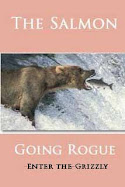Martin Buser, as has been his m.o. for the past several years, looked strong at the start but began his fade in the middle. And as has happened to every four time winner, Lance Mackey may be witnessing the end of the Mackey dynasty, four in a row and there aint no more. He is now running with Martin around 12th position.
There looks to be four mushers out in front making a race of it as they reach the coast and of the top nine mushers none have previously won the race. Go underdogs!
How hard is to win five races? It has only been done once before, by Musher Rick Swenson and how he won is one of the legends of Iditarod history. This was back in the day when the feud between Rick and Susan Butcher was as much fun to watch as the race itself. A walk down Iditarod memory lane From the New York Times, March 1991.
NOME, Alaska, March 15— On a day when the wind and the snow blowing off the Bering Sea Coast were so severe that he thought he might be risking his life, Rick Swenson of Two Rivers covered the final 77 miles to this historic gold-rush town and won the 19th annual Iditarod Trail Sled Dog Race early this morning.
By mushing his team through temperatures of 20 degrees below zero and winds of 40 miles per hour when most of the chief competitors turned back to shelter, Swenson became the first five-time winner of the 1,163-mile race from Anchorage to Nome.
Swenson, who last won the event in 1982, finished in 12 days 16 hours 34 minutes 39 seconds to win $50,000 and a new truck. In 16 Iditarod competitions, he has never finished out of the top 10. Boldness Is Rewarded
The victory rewarded Swenson's boldness in mushing his dog team into a bitter winter storm from White Mountain, the next-to-last checkpoint, and deflecting the challenge of his chief rival, Susan Butcher of Eureka, who was seeking to become the top-winning Iditarod competitor.
Butcher, winner of four of the last five Iditarods, and the event record-holder with a time of 11 days 1 hour 53 minutes was one of three front-runners who headed into the bad weather, but then turned back early Thursday morning. Before the storm, she was viewed as the likely winner.
"If I was going to walk, I wasn't going to turn back," said Swenson. "As long as I stayed on the trail, I wasn't going to die."
Butcher finished third, five and a half hours behind Swenson.
You couldn't tell if you were going up, down or sideways," said Swenson of the worst stretches of trail. "You couldn't tell anything. I never worked so hard for anything in my life. It was a little scary and it was stressful. It was not a pleasant night."
Swenson, 40 years old, said he did not even know that the others had gone back, but he was determined to push on. "There was no prize in White Mountain," he said.Susan quit racing after the 1994 race to concentrate on family, while Swenson has continued to race year after year. (Susan passed away from cancer in 2006). In this 1996 interview Swenson describes the single minded attention to your dogs that it takes to be competitive. That and age seems to be the determining factor in putting together multiple wins in this the "Toughest race on Earth.
Swenson expressed surprise that Butcher didn't fight the storm. "She's gonna have to get six now if she wants to be top dog," he said.
Butcher, in a concession speech at White Mountain, said she was "very, very, very happy for Rick."
----------------------------------------------------------------------------------------------------------
Leader John Baker of Kotzebue
The race today is led by Alaska Native John Baker who has built a two hour lead over the rest of the field. Bio from Iditrod.com:John Baker, 48, was born and raised in Kotzebue, Alaska. He began mushing in 1995 and was interested in the Iditarod after watching the Race in its early years. He ran his first Iditarod in 1996 and has been in every race since. He has 11 top ten Iditarod finishes, and in 2010 won both the Kusko 300 and the Kobuk 440.
Race Standings Here
----------------------------------------------------------------------------------------------------------
The Annual Salmon Hat Tip to the Iditarod Air Force which makes the race possible.

Weight and Balance? If it fits it flies.
Fuel; gas, kerosene, propane and gallons of Heet.






_edited-1.jpg)




No comments:
Post a Comment